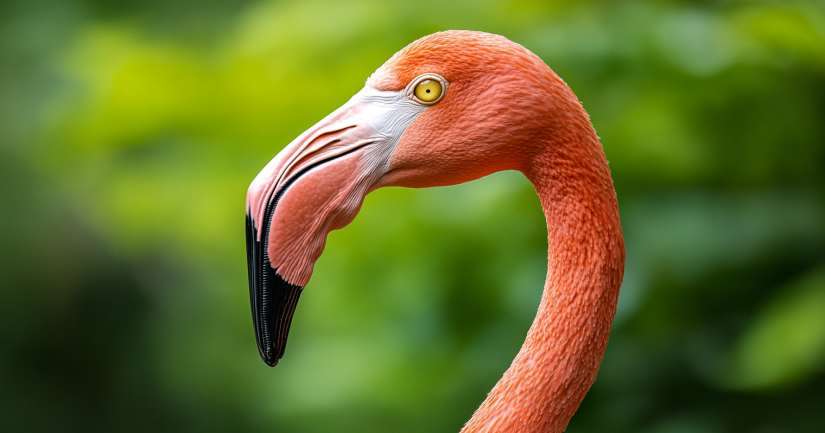
Are you ready to discover more about one of nature’s most fascinating creatures, Dive into our Flamingo Quiz – How Well Do You Know These Iconic Pink Birds? Flamingos are among the most recognizable birds in the world. This Flamingo Quiz will test your knowledge of these elegant, long-legged waders, known for their vibrant pink feathers, synchronized movements, and fascinating feeding behaviors. Found across Africa, the Americas, Europe, and Asia, these social birds thrive in salty lagoons and shallow lakes, where they create breathtaking flocks that can number in the thousands.
One of the most famous features of flamingos is their pink coloration, but they aren’t born that way. Chicks hatch with gray or white feathers, gradually turning pink due to the beta-carotene in their diet. The algae, brine shrimp, and other small organisms they consume contain pigments that influence their feather color. The richer the diet, the more vibrant the hue.
Fascinated by flamingos? Expand your bird horizons with the colorful Finch Quiz or marvel at the flightless wonders in the Emu Quiz.
Begin Your Flamingo Quiz Journey
Why Are Flamingos Pink? Key Facts for the Flamingo Quiz
Flamingo species vary in shade, ranging from pale pink to deep red. The American flamingo is among the brightest due to its high-carotenoid diet, while the Lesser flamingo has a subtler pink tone. Their unique color isn’t just for show—it plays a role in social ranking and mate selection, with deeper pink birds often considered healthier and more attractive.
Where Do Flamingos Live? Exploring Their Habitats and Social Structure
Flamingos are highly adaptable and found in saltwater lagoons, mudflats, and alkaline lakes across tropical and subtropical regions. They prefer shallow waters, where they can easily access their preferred food sources. Some of the largest flamingo populations reside in East Africa’s Rift Valley lakes, while others thrive in the Caribbean, South America, and parts of Europe and India.
As highly social birds, flamingos live in massive colonies that provide safety and cooperation. Large flocks work together during feeding, nesting, and predator avoidance. Their synchronized movements, whether wading through water or engaging in elaborate courtship dances, create an awe-inspiring sight.
How Do Flamingos Eat? The Science Behind Their Unique Beaks
Unlike most birds, flamingos have specialized, filter-feeding beaks designed to extract food from the water. They turn their heads upside down while feeding, using their comb-like structures, called lamellae, to strain tiny organisms from the mud and water.
Their tongues act like pumps, helping them push water through their beaks while trapping nutritious prey. This feeding method makes flamingos highly efficient foragers, allowing them to consume thousands of small crustaceans and plankton daily. Their specialized beaks are one of the most fascinating adaptations in the bird world.
Are Flamingos Endangered? Conservation Challenges and Efforts
While flamingos are widespread, some populations face habitat loss, climate change, and pollution. Wetlands, their primary breeding and feeding grounds, are under constant threat from human activity. In some regions, water diversion and mining disrupt their delicate ecosystems, making food sources scarce.
The Lesser flamingo, native to Africa and India, is particularly vulnerable due to declining wetland habitats. Conservation efforts focus on wetland protection, pollution control, and breeding programs to ensure stable populations. By preserving their environments, conservationists help maintain the delicate balance needed for these beautiful birds to thrive.
Are You Ready to Take the Flamingo Quiz?
Now that you’ve explored the world of flamingos, it’s time to put your knowledge to the test! This Flamingo Quiz will challenge you with fascinating questions about their behavior, biology, and conservation. See how well you know these pink-feathered wonders!
Check out our FULL collection of Bird Quizzes!
Flamingo – FAQ
A flamingo is a large wading bird known for its distinctive pink or reddish feathers, long legs, and elongated neck. These birds are primarily found in tropical and subtropical regions, inhabiting shallow lakes, lagoons, and mudflats, particularly in Africa, Asia, the Americas, and parts of Europe.
The pink coloration of flamingos comes from their diet, which consists largely of algae, brine flies, and crustaceans that contain carotenoids. These pigments are absorbed in the birds’ bodies and deposited in their feathers. The more carotenoids they consume, the more vibrant their coloration. Interestingly, younger flamingos are born gray and gradually develop their pink hues as they mature.
Flamingos are highly social birds that live in large colonies, sometimes numbering in the thousands. These colonies are vital for breeding and feeding. Within these groups, flamingos engage in various social behaviors, such as synchronized movements during courtship displays. This social structure also provides protection against predators.
Flamingos typically breed in large colonies, constructing mud nests where they lay a single egg. Both parents share the responsibility of incubating the egg, which takes about 28 to 32 days to hatch. Once the chick is born, it is gray and depends on its parents for food and protection. Flamingo parents feed their young by regurgitating partially digested food.
Flamingos are threatened by habitat loss due to climate change, pollution, and human encroachment. Additionally, changes in water levels and salinity can impact their feeding grounds. Conservation efforts are crucial to protect these unique birds and their habitats, ensuring their survival for future generations.
